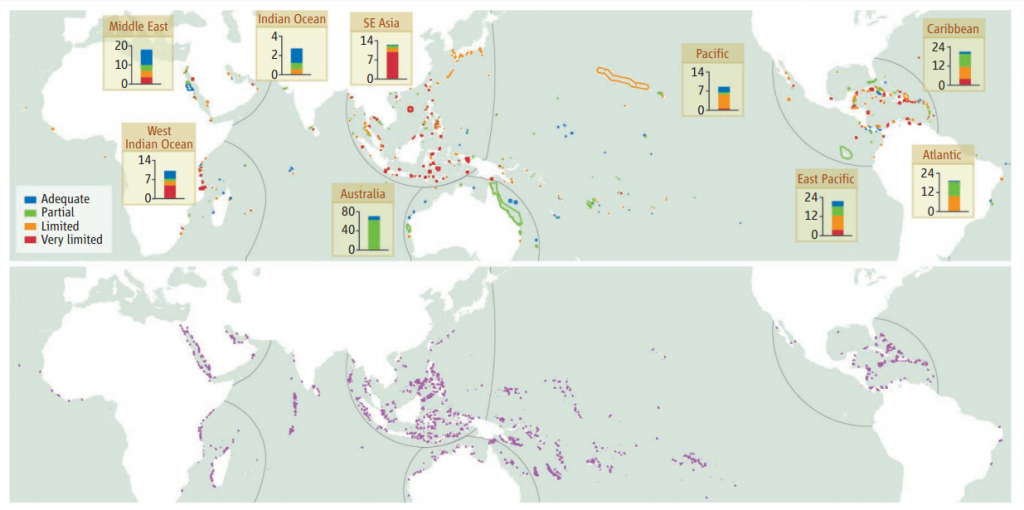Lately, coral reefs have been making headlines across the world because of their drastic decline and severe bleaching, but one story this week gives us a glimmer of hope. On March 20th, the Sun Sentinel reported that a proposal was unanimously passed by a Florida House of Representatives panel to create the “Southeast Florida Coral Reef Ecosystem Protection Area.”1 While this does not ensure any action on its own, a separate appropriations bill and Senate bill must be passed as well, this will allow monitoring to begin in the area so future plans can be prepared. This is a step in the right direction in a time when environmental budgets are being slashed across the country.
But what are protected areas, and why are they important?
The three main threats to coral reefs are eutrophication, overfishing, and climate change.2 While climate change is a global phenomenon, overfishing and eutrophication can be remedied on a more local scale, which is where marine protected areas come into play. There are various types of marine protected areas, or MPAs, but broadly, they are aquatic areas where human activity is limited or restricted for conservation purposes. The image below depicts both current MPAs across the globe as well as the number and location of MPAs that scientists believe is necessary going forward.

Figure 1. There are currently 980 registered marine protected areas globally. (Top) This figure displays the location of each MPA as well as a categorization of each MPA in terms of meeting attributes described in Mora et al. (Bottom) Each dot here represents a MPA needed to adequately protect coral reefs on a global scale. Source: Mora et al. in Science.5
There has been a lot of recent scientific literature lauding these protected areas in efforts to conserve coral reefs. In a report in Science, experts stated that at least 30% of coral reefs should be designated as no-take areas (NTAs), which are strict forms of MPAs where any form of exploitation is forbidden.3 This helps drastically in preserving the ecosystem of coral reefs, as reef fish are very influential in the trophic web and help keep macroalgae at bay.2 In 2014, Edgar et al. reported five main traits that dramatically increase MPA effectiveness: no take, well enforced, old (>10 years), large (>100 km2), and isolated by deep water or sand.4 This study reported greater large fish diversity and an increase in large fish and shark biomass, and concluded that more attention needs to be paid to MPA design, durable management and compliance to ensure that MPAs achieve their desired conservation value.4
However, not all scientists agree that MPAs are the way to go for reef conservation. Another paper in Science looked at the global effects of marine protected areas, instead of a local scale, and found them largely ineffective for reef conservation.5 This is due to global threats such as climate change, but also the widely dispersed nature of coral reefs. The authors claimed that throughout the current network of MPAs, only 2% of all coral reefs meet adequate attributes for conservation.5 The bottom image in figure 1 shows the proposed network of MPAs by the authors. While this is an important aspect of marine protected areas to consider going forward, it is my personal opinion that this study reinforces the need for large scale MPAs and extensive networks to properly protect coral reefs globally. Even if they are not effective in their current form, there is still hope for the future.
Overall, while there is active discussion on whether or not marine protected areas are the most efficient form of global conservation in their current form, they are effective management techniques for protecting reefs from local threats. MPAs are one way that humans are positively impacting, or at least reducing their negative impacts, on coral reefs, which is why they were featured in this blog on positive anthropogenic effects. There is still a lot of work to be done to research the best practices for these areas, as well as funding these projects and getting them approved by various governments, but if this network can be expanded, there may be hope yet for corals across the world.
Works Cited:
-
Sweeney, D. South Florida coral reef protection bill passes House panel. Sun Sentinel (2017).
- Correa, A. S. Coral Reef Ecosystems. (2017).
- Hughes, T. P. et al. Climate Change, Human Impacts, and the Resilience of Coral Reefs. Science 301, 929 (2003).
- Edgar, G. J. et al. Global conservation outcomes depend on marine protected areas with five key features. Nature 506, 216–220 (2014).
- Mora, C. et al. Coral Reefs and the Global Network of Marine Protected Areas. Science 312, 1750 (2006).

